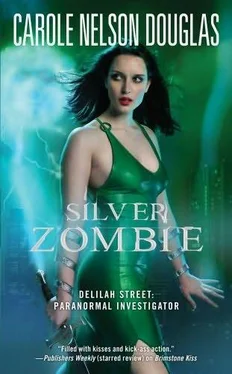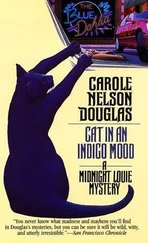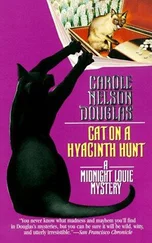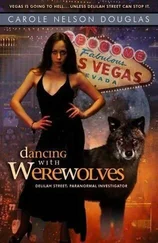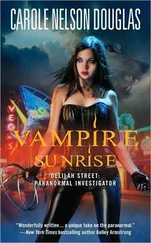Immediately, I recognized the astonishing, luminous images of an imagined ultramodern city combining the space opera scenery of Flash Gordon with the despair of a union movement for robotic workers.
Some would say this was the most classic film ever done by the German expressionist director, Fritz Lang. The studio and censors had hacked the film apart even before it was exported to the larger world. The Nazis would embrace the mechanized super-city as their own, making Lang loathe the product of his own genius. No complete authorized edition existed to this day. A rumored one found a few years ago in Rio had proved fraudulent.
“Snow,” I breathed, “what do you have here? Not the complete lost footage? That would be … priceless.”
His sunglassed gaze remained fixed on the screen. “I didn’t say ‘Holy Grail’ for nothing. Yes. Somehow the foot of the Oz rainbow pointed to the archives of a restored Wichita-area Art Deco movie palace, the Augusta, and this lost, rare, impossible footage. That’s what I want here. That’s what I’ll take back to the Inferno Hotel, an entire new wing built around this vintage futuristic vision. I’ll call it the New Metropolis Towers and Condominiums and maybe, if you treat me right, you’ll have visiting privileges.”
I was so freaking sold. “Imagine guests living in this vintage film city of the future. So the subterranean Nine Circles of Hell aren’t playground enough for you? You’re reconstructing the film world’s Art Deco Tower of Babel in Vegas? You realize those biblical Babel builders blasphemed?”
“You realize,” Snow said, “that ‘blaspheme’ is a pretty archaic concept? Especially in Vegas? Just tune in to your film fanatic mode, Delilah. I must say having you sitting here in that seriously anti-Code evening gown much enhances my viewing pleasure.”
“I would wear a green clown suit for the privilege of seeing Metropolis uncut.”
Snow chuckled, returning his hidden gaze from the screen. “I knew you’d appreciate this.”
It’s hard to overstate how rare this film was. The Holy Grail of vintage films indeed. Remembering it was twelve years from the grim but luminous black-and-white futuristic robotic fable of Metropolis to the hypercolorized, deceptively happy fable of The Wizard of Oz shows how fast the art of film developed—by leaps and bounds—and so had its audience.
I rapidly scanned my all-things-vintage memory bank.
Metropolis was a dark antitechnology tale of Maria, a sweet, loving girl who became the movie’s model for the ultimate roboticized worker-drone. The “manufactured” robot queen bee built on Maria in Metropolis had inspired George Lucas to create the shiny gold C-3PO robot in the Star Wars film saga, but a more recent descendent was Seven of Nine, that sexy mechanical Borg female “construct” of nineties Star Trek television.
Now I stared at the moments of heroine Maria’s on-screen re-creation, a human woman being made into a silver-metal superwoman, perhaps the most powerful image of feminine power since the Neolithic fertility goddesses. Only this dame wore body armor.
She stood on platform soles of solid metal. She packed it at the hips like a gunslinger, and don’t we all, a little? I was reminded of the secondhand cop duty belt I wore for action expeditions. Her metal-gloved hands curved out from the sides of her thighs. Like a gunslinger’s.
Her torso was covered by a stiff metal “stomacher” bodice Queen Elizabeth I (no monarch to mess with anywhere, anytime) would wear.
Her breastplate was topped off by steel cannonballs, size 36C. Her shoulders stood up high and rounded too, and her neck sinews combined something of the swan with something of the suspension bridge.
Her face was sculpted in perfect symmetry, but blank of eye, taut of lip, and dominated by a nose that soared into a delicate pillar to the top of her head, which wore a smooth metal bonnet. She looked like she’d never had a bad hair day, having no visible hair. She also looked like she could kick Alien ass or take down Billy the Kid. Or both at the same time. She was eternal. And she was awesome.
So was the visionary film world that had created her.
I watched, mesmerized, aware that Snow alone had the chutzpah to reconstruct this vanished apocalyptic vision of Metropolis in Las Vegas. Of course, in the film, the robotic superwoman had been destroyed. That would not happen again, from the rapt way Snow’s sunglasses fixed on the screen. She would escape pre-WWII Germany and get her full second round in post–Millennium Revelation Las Vegas.
“Why are you showing this to me?” I asked, hardly noticing the time until the 153-minute film had burst like a bubble on the dark screen and vanished. But my absinthe glass was empty.
“You always want answers, Delilah Street,” Snow said, stretching out his white ostrich-skin boots and lacing his hands behind his neck in a way that showcased his long, dramatic frame. “The mysteries Wichita holds for you are far more serious than my being here. But … the film I’ve just acquired is a lost treasure few would appreciate. I simply wanted to show it to somebody.”
Unsaid was the fact he wanted to show it to somebody who understood what a rarity it was, that he needed my mind and companionship. For an instant, I actually felt sorry for him. It must be lonely at the pinnacle.
And then I got one of my intuitive glimmers. “How did you find this here in Wichita? Through the Augusta Theater restoration, but only you knew what it was, didn’t you?”
His long, white, lazy fingers reached out to touch the silver bracelet I hadn’t realized had made a green circle of thorns on my wrist. The familiar morphed again into a green-enameled silver garter snake, reared a tiny scaled head, and hissed at him.
He laughed, but withdrew his hand.
“Yes,” he said. “I’ve hired what the antique dealers call ‘pickers’ to look for it for decades. The Augusta is a 1935 movie theater on the National Register of Historic Places. It was never a huge urban film palace, but it is pure Art Deco, rather similar to how you’re looking now, Delilah, all green and silver and black, like your sterling serpent. It’s been restored on a shoestring by devoted locals, and no one was more surprised than I to find that an uncut version of Metropolis numbered among their souvenirs. Of course, they had no idea what they had.”
“Of course,” I told him. “I just didn’t understand why you’d share the find of several lifetimes with me.”
“Is that all you want to know after seeing Metropolis ? Come on, Delilah, you can be cheekier than this.”
I studied my host, an enigma who was as ancient as a same-named medieval Christophe … as modern and deadly as Cocaine … as cozy-familiar and icy as Snow.
I held my breath while Irma bit her tongue. My tongue wasn’t so easy to harness.
“Why aren’t you giving the Brimstone Kiss after your shows anymore?” I asked, not having planned to go there.
He braced his elbows on the theater seat arms and again ran his albino fingers into the hair at his temples as if he had a nagging headache. Me, I hope.
“Why?” I demanded. “The fabled Brimstone Kiss was your signature. Did I … use it up?”
I was thinking that maybe he … it had only one life to give …
Jeez, that sounded like the title of a long-gone soap opera.
He turned to face me, the unreadable sunglasses burning like coal into my anxious regard.
“Nothing to do with you, Delilah. Sorry.” A slight smile lifted his lips. “I can’t be tied down to a concert schedule anymore, you see. That’s why I moved the Seven Deadly Sins to Vegas.”
Читать дальше
